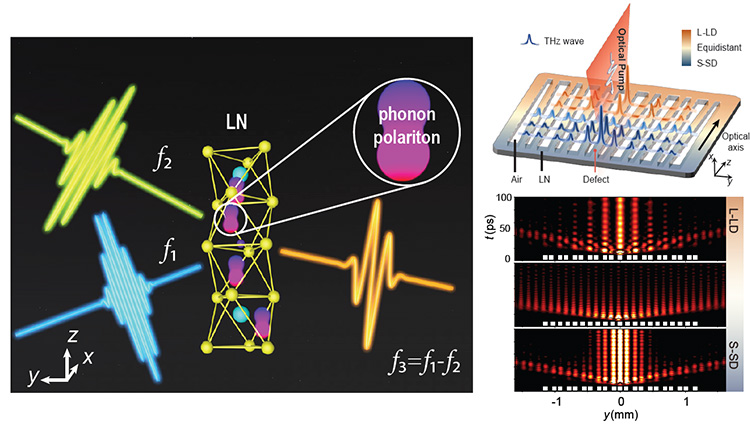 Nonlinear THz frequency conversion and topological tuning in an LN chip (see accompanying video). Left: Illustration of THz frequency conversion mediated by phonon polaritons. Top right: Illustration of chip-scale LN with a wedge-shaped structure. Bottom right: THz waves evolving in different regions of Su-Schrieffer-Heeger lattice under topological tuning.
Nonlinear THz frequency conversion and topological tuning in an LN chip (see accompanying video). Left: Illustration of THz frequency conversion mediated by phonon polaritons. Top right: Illustration of chip-scale LN with a wedge-shaped structure. Bottom right: THz waves evolving in different regions of Su-Schrieffer-Heeger lattice under topological tuning.
Terahertz (THz) on-chip communication with compact topological devices and high-rate data transmission could enable future artificial-intelligence and cloud-based technologies1. A key challenge in reaching such goals is controlled THz generation, confinement and detection, preferably in a compact integrated device.
Recently, we have developed THz frequency-tuning techniques using a lithium niobate (LN) photonic chip that have allowed for very efficient nonlinear THz frequency conversion,2 exotic phase-matched transport of “frozen-phase” THz waves,3 and the topologically tuned confinement of THz waves upon nonlinear generation.4 These works raise new possibilities for versatile, stable and highly integrated multifunctional THz photonic circuits for applications including THz computing, imaging and fingerprint detection.
For decades, researchers have sought efficient nonlinear effects at THz frequencies by raising the input power. Conversion efficiency, however, remained low in chip-scale nonlinear crystals, although LN has yielded brilliant nonlinear features in the visible or near-infrared spectrum. To effectively enhance the THz nonlinearity, we proposed a scheme based on nonlinear Huang equations, generalized from the well-known Huang equations in lattice dynamics,5 to highlight the unique role of phonon polaritons in enhancing THz nonlinear effects.2 As THz waves can be in resonance with optical phonons in most ionic crystals, they may provide an external force on phonon polaritons, thus directly linking the nonlinear polarization field to the ionic polarity.
We achieved a giant THz nonlinear frequency conversion in an LN chip by utilizing phonon polaritons. The nonlinear susceptibility of the THz difference-frequency generation reached around 10–6 m/V, about five orders of magnitude higher than previous results. This work provides a new approach toward high nonlinearity in chip-scale LN, required by THz nonlinear technologies.
In other experiments, we designed a wedge-shaped topological Su-Schrieffer-Heeger lattice on an LN chip.4 Upon nonlinear excitation by a femtosecond laser, THz waves were generated and switched from a topologically nontrivial defect mode (the “long-long defect” [L-LD]) to a bulk mode (transition point), and then to a trivial defect mode (the “short-short defect” [S-SD]), exhibiting tunable confinement and THz topological mode population along the LN chip. Such a topological control of THz waves may bring about new possibilities in realizing THz integrated circuits, promising for advanced topology-driven photonic applications.
These studies open an avenue for THz wave generation, confinement, and detection in a multifunctional integrated chip-scale device, which may find applications in numerous systems with characteristic THz fingerprints. The observed giant nonlinearity for THz waves is promising for optical control of spin qubits in semiconductors as well as manipulation of many ionic and ferroelectric/ferromagnetic crystal properties.
Researchers
Yao Lu, Jiayi Wang, Shiqi Xia, Qiang Wu, Xinzheng Zhang, Daohong Song, Zhigang Chen and Jingjun Xu, Nankai University, Tianjin, China
Roberto Morandotti, INRS-EMT, Varennes, QC, Canada
References
1. Y. Yang et al. Nat. Photon. 14, 446 (2020).
2. Y. Lu, et al. Nat. Commun. 12, 3183 (2021).
3. Y. Lu et al. Laser Photon. Rev. 15, 2000591 (2021).
4. J. Wang et al. Light Sci. Appl. 11, 152 (2022).
5. K. Huang. Proc. R. Soc. A 208, 352 (1951).
